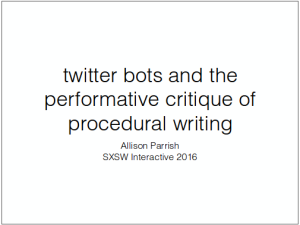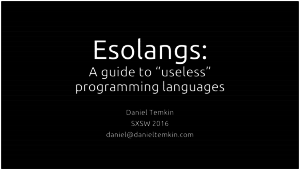We had a great panel at SXSW Interactive on March 11, exploring several radical ways in which langauge and computing are intersecting. It was “Hacking Language: Bots, IF and Esolangs.” I moderated; the main speakers were Allison Parrish a.k.a. @aparrish; Daniel Temkin
DBA @rottytooth; and Emily Short, alias @emshort.
I kicked things off by showing some simple combinatorial text generators, including the modifiable “Stochastic Texts” from my Memory Slam reimplementation and my super-simple startup name generator, Upstart. No slides from me, just links and a bit of quick modification to show how easily one can work with literary langauge and a Web generator.
Allison Parrish, top bot maker, spoke about how the most interesting Twitter bots, rather than beign spammy and harmful or full of delightful utility, are enacing a critique of the banal corporate system that Twitter has carefully been shaped into by its makers (and compliant users). Allison showed her and other’s work; The theoretical basis for her discussion was Iain Borden’s “Another Pavement, Another Beach: Skateboarding and the Performative Critique of Architecture.” Read over Allison’s slides (with notes) to see the argument as she makes it:
Daniel Temkin introduced the group to esoteric programming languages, including several that he created and a few classics. He brought copies of a chapbook for people in the audience, too. We got a view of this programming-language creation activity generally – why people devise these projects, what they tell us about computing, and what they tell us about language – and learned some about Temkin’s own practice as an esolang developer. Take a look at Daniel’s slides and notes for the devious details:
Finally, interactive fiction author Emily Short reviewed some of the classic problems of interactive fiction and how consideration has moved from the level of naïve physics to models of the social worlds – again, with reference to her own IF development and that of others. One example she presented early on was the challenge of responding to the IF command “look at my feet.” Although my first interactive fiction, Winchester’s Nightmare (1999) was not very remarkable generally, I’m pleased to note that it does at least offer a reasonable reply to this command:

That was done by creating numerous objects of class “BodyPart” (or some similar name) which just generate error messages. Not sure if it was a tremendous breakthrough. But I think there is something to the idea of gently encouraging the interactor to o play within particular boundaries.
Emily’s slides (offering many other insights) may be posted in a bit – she is still traveling. I’ll link them here, if so.
Update! Emily’s slides are now online — please take a look.
I had a trio of questions for each pair of presenters, and we had time for questions from the audience, too. The three main presenters each had really great, compact presentations that gave a critical survey of these insurgent areas, and we managed to see a bit of how they speak to each other, too. This session, and getting to talk with these three during and outside of it, certainly made SXSW Interactive worth the trip for me.
There’s an audio recording of the event that’s available, too.



